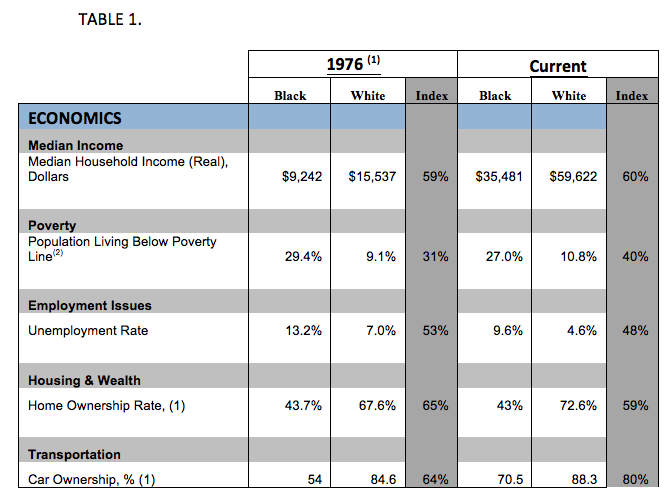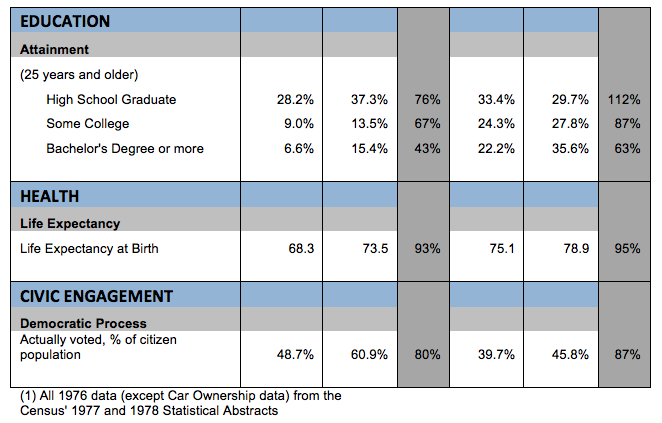Forty years ago – on February 2, 1976 – The New York Times wrote an article titled “Distress Signal,” which reported on the first edition of the National Urban League’s State of Black America report. The article noted:
“The report on the state of black America released last week by the National Urban League is a profoundly depressing document. Beyond the statistics it contains – gloomy enough by themselves – the report dramatizes a substantial failure of political leadership.
Vernon Jordan, Jr., the league’s executive director, noted that the State of the Union Message by President Ford omitted all mention of the plight of black Americans while Senator Edmund S. Muskie in his reply on behalf of the Democrats, omitted the promise of racial equality from his list of endangered American promises.
The report is replete with facts backing up the league’s conclusion that no recent year ‘has been more destructive to the progress of blacks than 1975.’
…the message is clear. In aspects of life that can be measured statistically, the gains made in the sixties by America’s largest minority group have been decimated. And in intangible terms – those relating to the demands for equality urged on the nation’s conscience by its leaders – all gears have been thrown into reverse.
In addition to the moral failures this report underscores – which by themselves are highly significant – it dramatizes unwholesome and even frightening social policy trends. Such severe distress in any single segment of society is bound to have large consequences throughout all of American life. Nothing demonstrates this quite so well as the current precarious financial plight of so many of the nation’s cities.
In the end, then, the conditions described by the Urban League constitute a substantial challenge to the country’s political leadership, not simply to redeem a central aspect of American idealism, but to reverse a dangerous disintegration in the social fabric of the entire nation.”
This year, as the National Urban League celebrates the 40th anniversary of the State of Black America report, it continues to interject serious consideration of the social, economic and political issues facing African Americans into the national discourse. While aggregate improvements can be noted across the board for Blacks and whites, unfortunately the findings tell a clear story that significant disparities remain and have not been resolved by any gains, particularly in income and employment.
In 1976, schools had been legally desegregated for 22 years, the Civil Rights Act of 1964 was 12 years old, the Voting Rights Act of 1965 had been in place 11 years, and the economy was one year into economic recovery from the recession that lasted from November 1973 to March 1975. Still, Blacks were nearly twice as likely as whites to be unemployed; the median Black household had only 59 cents for every dollar of income in the median white household; and African Americans were three times more likely to live in poverty than whites.
While these racial disparities continued to persist more than a decade after several pieces of landmark equal rights legislation had passed, that’s not to say there had been no progress. The State of Black America 2013 presented a 50-year retrospective on the March on Washington for Jobs and Freedom – one year before the Civil Rights Act of 1964 was signed into law -- which is a useful point of comparison. Between 1963 and 1976, Blacks experienced tremendous gains in school enrollment and educational attainment. In 1963, only one-quarter of Black adults had completed high school. By 1976, that number had grown to 43.8 percent. At the college level, there were more than twice as many Black 18-24 year olds enrolled in college in 1976 than in 1963. The standard of living for Black Americans had also risen over that 13-year period. Despite the fact that the Black poverty rate was three times the white rate both in 1963 and 1976, poverty rates for both groups had fallen significantly over that time (down 21.6 and 6.2 percentage points for Blacks and whites, respectively). By 1976, the Black-white income gap had closed 6 percentage points (from 53% in 1963) and the homeownership gap had closed 10 percentage points (from 55% in 1963 to 65% in 1976).
Since 1976, educational progress has continued. Eighty-six percent of African Americans are high school completers; the share with a bachelor’s degree or more has more than tripled (from 6.6% to 22.2%); and roughly one-third of 18-24 year-olds are enrolled in college. While whites have increased college enrollment faster than Blacks between 1976 and 2014 (most recent data available), the college completion gap has narrowed 20 percentage points over this time (from 43% in 1976 to 63% in 2014).
However, despite notable absolute progress for Black America, there has been much less relative progress towards economic equality with whites, especially when compared to the progress made toward educational equality. This is especially notable when it comes to unemployment. With few exceptions, the Black unemployment rate has consistently remained about twice the white rate across time and at every level of education. Compared to 40 years ago, the income gap has remained basically unchanged (now at 60%), and the homeownership rate gap has actually grown 6 percentage points (now at 59%). The foreclosure crisis has left Black homeownership rates at approximately the same point they were in 1976, while the white homeownership rate is now 5 percentage points higher. On the other hand, there has been slow, but ongoing progress in reducing poverty, in spite of the economic challenges presented by the Great Recession. According to the most recent estimates, the Black poverty rate is now 2.4 percentage points lower than in 1976 (down to 27% from 29.4%).
Finally, in an election year, progress in voter participation is mixed. While the percentages of Blacks and whites who actually voted in the last election are both much lower than the percentages in 1976, this is partly due to the fact that these data are comparing a presidential election year (1976) with a non-presidential election year (2014). Voter participation drops considerably in mid-term election years. However, even with this decline in participation, that gap between Blacks and whites has narrowed 7 percentage points, suggesting that Black civic engagement has declined by less than that of whites.



 Equality Index
Equality Index  Senate Report
Senate Report  2020 SOBA Essays
2020 SOBA Essays  2019 Report
2019 Report 